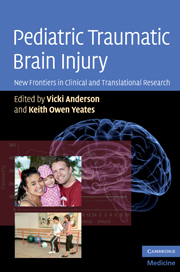Book contents
- Frontmatter
- Contents
- List of contributors
- Acknowledgments
- Introduction: Pediatric traumatic brain injury: New frontiers in clinical and translational research
- 1 Biomechanics of pediatric TBI
- 2 Neurobiology of TBI sustained during development
- 3 Using serum biomarkers to diagnose, assess, treat, and predict outcome after pediatric TBI
- 4 Clinical trials for pediatric TBI
- 5 Advanced neuroimaging techniques in children with traumatic brain injury
- 6 Neurobehavioral outcomes of pediatric mild traumatic brain injury
- 7 Very long-term neuropsychological and behavioral consequences of mild and complicated mild TBI: increased impact of pediatric versus adult TBI
- 8 Neurobehavioral outcomes of pediatric traumatic brain injury
- 9 Neuropsychological rehabilitation in children with traumatic brain injuries
- 10 Psychosocial interventions
- 11 Pediatric TBI: challenges for treatment and rehabilitation
- 12 Integrating multidisciplinary research for translation from the laboratory to the clinic
- Index
- Plate section
- References
2 - Neurobiology of TBI sustained during development
Published online by Cambridge University Press: 14 May 2010
- Frontmatter
- Contents
- List of contributors
- Acknowledgments
- Introduction: Pediatric traumatic brain injury: New frontiers in clinical and translational research
- 1 Biomechanics of pediatric TBI
- 2 Neurobiology of TBI sustained during development
- 3 Using serum biomarkers to diagnose, assess, treat, and predict outcome after pediatric TBI
- 4 Clinical trials for pediatric TBI
- 5 Advanced neuroimaging techniques in children with traumatic brain injury
- 6 Neurobehavioral outcomes of pediatric mild traumatic brain injury
- 7 Very long-term neuropsychological and behavioral consequences of mild and complicated mild TBI: increased impact of pediatric versus adult TBI
- 8 Neurobehavioral outcomes of pediatric traumatic brain injury
- 9 Neuropsychological rehabilitation in children with traumatic brain injuries
- 10 Psychosocial interventions
- 11 Pediatric TBI: challenges for treatment and rehabilitation
- 12 Integrating multidisciplinary research for translation from the laboratory to the clinic
- Index
- Plate section
- References
Summary
Introduction
Changes in brain growth and connectivity continue throughout an individual's lifespan. The most rapid period of cerebral changes are observed during infancy and childhood but have recently been shown to continue into early adulthood (Toga et al.,2006). While the pediatric population as a whole shows robust differences across countless variables compared to the “adult” or mature brain, there are also significant differences between subgroups within the pediatric population. The pediatric population is not a homogenous group, but rather is made up of subgroups as defined by their developmental profiles for a given parameter. Despite the fact that increasing clinical and experimental evidence reveals age-related differences in response to traumatic brain injury (TBI) within the pediatric population, there remains a lack of appreciation for these differences when establishing standards of care for children. Many parameters (serum glucose management) continue to be “modified” from adult practice without direct knowledge of age-related responses. These findings emphasize the fact that developmental physiology impacts the pathophysiological response to traumatic brain injury and ultimately influences developmental disability.
Traumatic brain injury early in life
Myelination and compliance
Changes in cerebral myelination continue throughout adolescence into early adulthood (Courhesne et al., 2000; Giorgio et al., 2008; Paus et al., 1999). As brain myelin content increases, brain water content decreases (Himwich, 1973) with consequent changes in the biomechanical properties of the brain.
- Type
- Chapter
- Information
- Pediatric Traumatic Brain InjuryNew Frontiers in Clinical and Translational Research, pp. 18 - 35Publisher: Cambridge University PressPrint publication year: 2010

